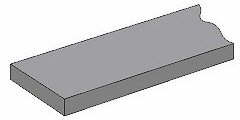Making a blade. 
In these pages I will attempt to explain how to
make a blade from a piece of carbon spring steel.
Depending on where you live, one of the problems may be obtaining the
steel in the first place.
NOTE: I claim no responsibility for your safety or the safety
of others during the processes contained in these pages. ALWAYS wear
a protective gear when working with steel. A MINIMUM amount of protective
gear would include safety goggles, dust filter and ear muffs. You
have been warned.
Look at as many Nihontô photos as you can to decide what
style you like. Then work out the dimensions from the photo.
Remember to allow for the kissaki (point) of the blade.
Next, select a piece of steel of the appropriate dimensions, from which
a blade can be produced.
This example uses an 8 mm x 70 mm x 115 cm piece. I found that
5mm thick pieces were too thin to work with when starting.
By splitting the 70 mm piece on a slight diagonal there will be enough
steel to make 2 blades.
First I spray primer on the steel then mark out a line.

With the piece split into 2, take 1 of the pieces to make a blade.


For the sake of this example I have decided to make a
katana with a blade width that decreases from 31 mm (near the hilt) to 22 mm at the tip. The blade length will be around
72 cm.
This blade will have a 4.5 cm kissaki (point) so measure 4.5 cm
back from the end of the strip and place a dot 22 mm from the edge.
Next measure about 73 cm from the end of the strip and place a dot
22 mm from the edge.
Note that the edge is not the one just created from splitting the steel,
but the original outside edge of the strip.
If you wish to increase distal taper then mark a line at 24 mm near the tip
and 22 mm at the base. You may think that the taper from 24 mm (at the tip) to 22 mm (at the
base) goes in the wrong direction, but grinding the blade out in this fashion
will create a greater distal taper and increase the angle of the cutting
edge nearer the point.
[NEXT]
This page has been accessed  times.
times.
This page was updated Wednesday 15th January 2003




